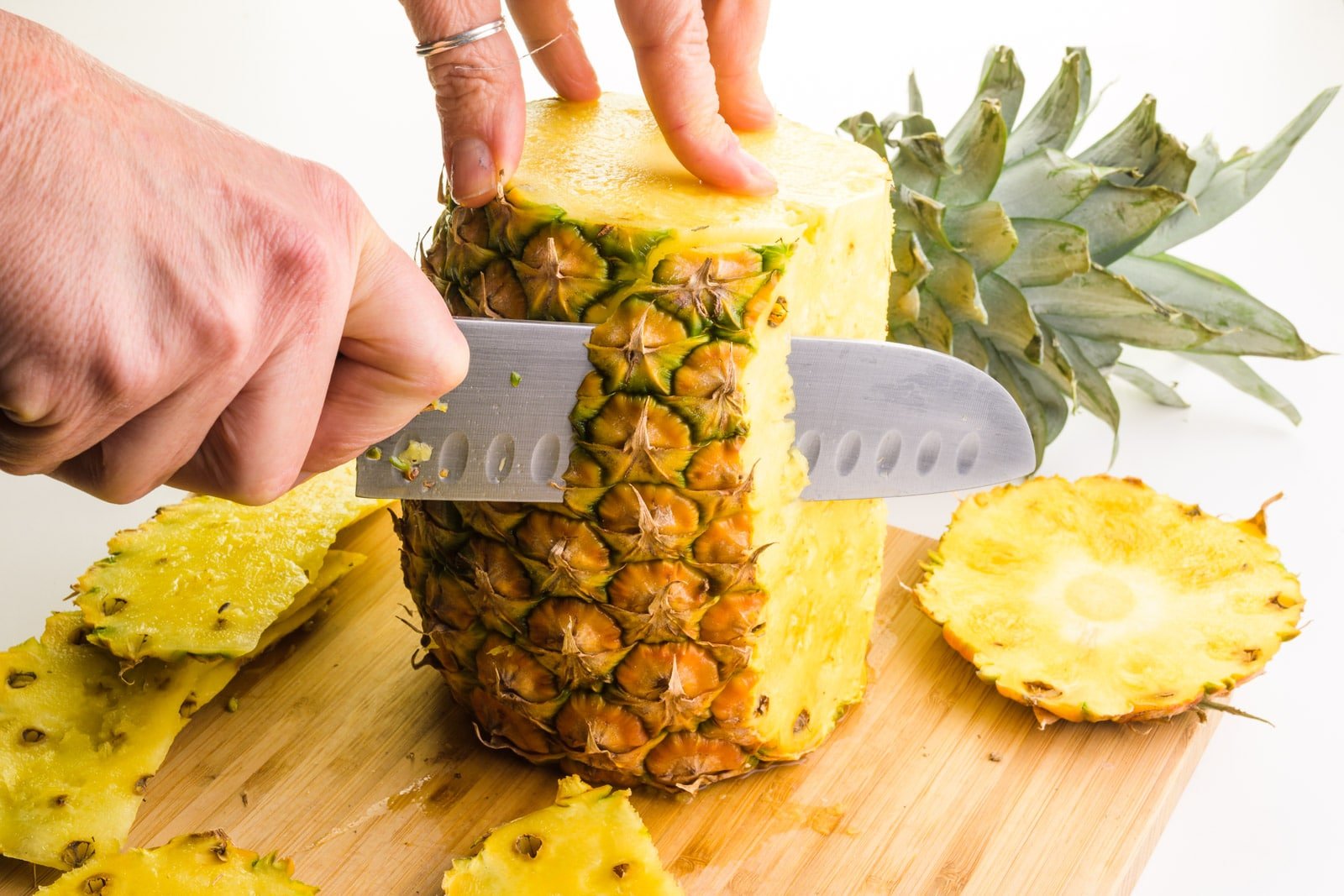Pineapples, with their vibrant tropical flavor and refreshingly juicy texture, are a favorite among fruit lovers. However, their spiky exterior and tough core can make them seem daunting to prepare. Fear not, for this comprehensive guide is designed to demystify the process of cutting a pineapple. By following these simple steps, you’ll be able to enjoy this delicious fruit in no time.
Selecting the Perfect Pineapple
Before you wield your knife, the first step is choosing the right pineapple. A ripe pineapple is key to enjoying the best taste and texture. Look for a fruit that has a slight give when pressed, a vibrant yellow hue at its base, and a sweet, fragrant aroma at the bottom. The leaves should be green and fresh-looking. Avoid pineapples with soft spots, bruises, or a fermented smell, as these are signs of overripeness or spoilage.
Preparing Your Workspace
Safety and cleanliness are paramount when cutting any fruit, especially one as tricky as a pineapple. Ensure you have a clean, flat surface to work on and a sharp chef’s knife. A dull knife can make the task more difficult and dangerous. Also, have a cutting board ready—preferably one that is stable and won’t slip. Washing your pineapple under cold running water before cutting can help remove any potential dirt or contaminants.
The Initial Cuts
Removing the Top and Bottom
Start by laying the pineapple on its side on your cutting board. Slice off the top and bottom of the pineapple, about half an inch from the ends. This creates a stable base and top for further slicing. Discarding the top and bottom, stand the pineapple upright on its now flat base.
Peeling the Skin
With the pineapple standing upright, start slicing off the skin from top to bottom. Follow the curve of the pineapple, and try to remove as much of the brown ‘eyes’ as possible in this process. However, don’t worry if some remain; there’s a technique for removing those later. Repeat this process around the pineapple until all the skin is removed.
Removing the Eyes
The ‘eyes’ of the pineapple are tough and not pleasant to eat. To remove them, you can either make shallow diagonal cuts around the pineapple to carve them out, or use a pineapple corer if you have one. The goal is to remove the eyes while preserving as much of the fruit as possible.
Cutting the Pineapple
Slicing into Quarters
Once the pineapple is peeled and the eyes are removed, lay it on its side and cut it in half from top to bottom. Then, cut each half again in the same manner, resulting in four long quarters.
Removing the Core
Each quarter of the pineapple contains a tough, fibrous core that is not enjoyable to eat. To remove it, stand each quarter upright and slice down the inner edge to separate the core from the edible flesh. Discard the core.
Cutting into Chunks or Slices
After coring, you can choose to cut your pineapple into whatever shape suits your needs. For chunks, lay each quarter down and slice it into bite-sized pieces. For slices, simply cut each quarter crosswise into your desired thickness. Remember, the thickness will affect the texture and juiciness of the pineapple pieces, so consider your personal preference or the requirements of your recipe.
Storage Tips
If you’re not planning to eat your pineapple immediately, storing it properly is crucial to maintaining its freshness. Pineapple chunks or slices should be placed in an airtight container and can be stored in the refrigerator for up to five days. For longer storage, pineapple can be frozen in a single layer on a baking sheet before being transferred to a freezer bag, allowing you to enjoy it for up to six months.
Conclusion
Cutting a pineapple may seem like a laborious task, but with the right tools and techniques, it becomes a simple process that anyone can master. By selecting a ripe pineapple, preparing your workspace, and following the steps outlined in this guide, you’ll be able to efficiently cut pineapple and enjoy this delicious, tropical fruit anytime. Remember to store any leftovers properly to extend the life of your pineapple, ensuring you can savor its sweetness for days to come. Whether you’re enjoying it on its own, as part of a fruit salad, or as a sweet addition to savory dishes, fresh pineapple is a versatile ingredient that can elevate your culinary creations.
Frequently Asked Questions (FAQs)
1. How do I know if a pineapple is ripe?
A ripe pineapple will have a slight give when gently squeezed. The base should emit a sweet, tropical fragrance, and its color will be more yellow than green. The leaves should be green and relatively easy to pluck.
2. Can I eat the core of a pineapple?
While the core of a pineapple is edible, it is much tougher and less juicy than the rest of the fruit. Some people prefer to remove it for a better texture, but it can be consumed if desired.
3. What can I do with the leftover pineapple skin and core?
The skin and core of a pineapple can be used to infuse water or make tea. They can also be composted, making them a zero-waste option.



















